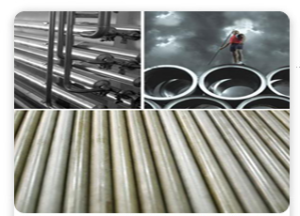Tubes and pipes are ruling the industrial sector. Nowadays, for every business the requirement for seamless and HYDRAULIC TUBES has become invariable. They supply a smooth flowing of liquids without bearing hindrance or getting dry. HYDRAULIC TUBES work best when they are painted in white. As you know, they have various functions ranging from the aerospace industry to power-plants. These tubes are built with strong and robust materials which make them a permanent asset for the buyers. They do not react to hot summers nor succumb to damages in the monsoon. They serve as a long time investment to industrial buyers. Fabricated with latest technology the entire product range of HYDRAULIC TUBES, ensure a perfect finish with corrosion resistance.
Anand Seamless Tubes offer a full range of Cold Drawn Seamless Tubes to meet ASTM, BS, DIN and EN Standards, for applications in a wide spectrum of industries.
Saturday, 25 July 2015
Wednesday, 8 July 2015
SEAMLESS TUBES-THE HEART OF AUTOMOTIVE INDSUTRIES
The success of the entire automotive industry depends on the cold drawn seamless tubes. They have an enormous wall thickness and are mainly made from alloy, fiberglass and stainless steel. Right from the car manufacturing to oil and gas industries, the cold drawn seamless tubes play a very important role in all types of mechanical functions. When an individual from the engineering or machine industry buys these cold drawn seamless tubes he is sure to get the best result in his production and manufacturing process. His work would be done effortlessly and without any ado.
PROCESSING & FUNCTIONS
The cold drawn seamless tubes are produced in carbon, steel and different alloy grades. Their dimensional tolerance is comparatively closer, they have better finishing surfaces and have rich mechanical properties compared to the hot finished seamless tubes. These tubes are manufactured by 2 main processes:
- Rotary piercing and
- Thermal process
While piercing a seamless tube the metal is worked from the interiors as well as the outside part. A solid bar is transformed into a hollow shell by moving the material over a mandrel during the rolling of the rotary. The whole process removes the impurities and becomes uniform.
Simultaneously, the tubing process lengths itself, to reach a perfect wall thickness and rolls to achieve the outside diameter. The rotary sizing circulates the tube diameter to complete the final requirements. The whole process is closely examined for producing an unvarying tube with exact properties from the surface.
The mechanical tubes are also cleaned by the thermal process. In this process the layer is made to dry through heating, where it becomes a bit like chip because of the loss of its flexibility and elasticity. It is then discharged by a medium or a rinsing liquid. The temperature is calculated and determined and according to that requirement, the heating can be in a parallel tube or in an induction heating process.
The properties of mechanical tubes vary from the cold drawn ones. They have a fine quality of machinery and uniform properties for faster cutting speeds, decrease in tool wear and set up times.
COLD DRAWN TUBES USAGE
The cold drawn tubes offer higher rate of tolerances and stronger physical properties compared to other hot finished tubes and pipes. These tubes are quite popular in hydraulics where they are used to make an empty chrome plated telescopic cylinders and rods based on hydraulic process. Not only these, but they are also popular for heavy walled, large bore and hydraulic cylinders with high pressures. For the production of heavy gadgets like garbage trucks and cranes the cold drawn seamless tubes partake the first position.
POINTS TO BE NOTED
The mechanical tubes along with the cold drawn do not just require the pointing and drawing. We have to acquire the raw materials, pointing, drawing, straightening and finishing. These are the 5 main aspects we have to keep in mind.
FINISHING PROCESS
- The tubes are drawn to a finishing process through this steps:
- Plug drawing
- mandrel or rod drawing
- sinking along with fixed, floating and tethered semi-floating processes.
Subscribe to:
Comments (Atom)

